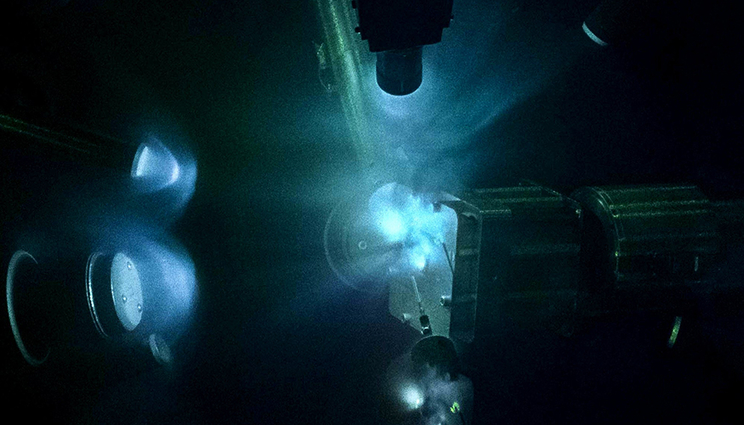Record experiments probe exoplanetary cores
 (Download Image)
The inside of the target chamber at the Omega Laser at the University of Rochester’s Laboratory for Laser Energetics, where lasers are being used to compress iron-silicon samples to ultra-high pressure conditions of exoplanetary cores. Credit: Laboratory for Laser Energetics
(Download Image)
The inside of the target chamber at the Omega Laser at the University of Rochester’s Laboratory for Laser Energetics, where lasers are being used to compress iron-silicon samples to ultra-high pressure conditions of exoplanetary cores. Credit: Laboratory for Laser Energetics
Using high-powered laser beams, iron-silicon alloys have been compressed to unprecedented pressures corresponding to the center of a three-Earth-mass extrasolar planet. The resulting measurements of crystal structure and density provide new insights into the nature of the deep interiors of the large, Earth-like planets that have been discovered throughout our galaxy.
The research, published today in Science Advances, was led by June Wicks, assistant professor at Johns Hopkins University, with colleagues from Lawrence Livermore National Laboratory, Princeton University and the University of Rochester.
Of the thousands of planets now known to orbit other stars in our galaxy, those with sizes ranging between Earth and Neptune are among the most abundant. These planets have attracted much attention because there are no direct analogues for them in our own solar system and they provide insights into the types of possible planetary architectures that may exist in our galaxy. However, the interior pressures in such planets can reach up to 10 times or more the pressure at the center of the Earth. These conditions are beyond the range of conventional experimental techniques, leaving the structure and composition of the interior of such bodies largely unknown.
The researchers were able to reach ultra-high pressures -- more than 13 million atmospheres -- by compressing the iron-silicon alloy using the Omega laser, located at the University of Rochester’s Laboratory for Laser Energetics. This pressure is more than three times the pressure at the center of the Earth and constitutes the highest X-ray diffraction measurements ever reported. The sample was compressed for only a few billionths of a second, but this was enough for the researchers to probe the atomic structure of the sample using a pulse of bright X-rays.
"From cosmochemical and geophysical constraints, we know that the Earth’s core is composed of iron alloyed with about 10 percent lighter elements. The abundance and identification of light core elements are crucial for constraining the bulk chemistry of the Earth, the process of core formation and its subsequent thermal and magnetic evolution," Wicks said. "A number of lines of evidence make silicon a likely candidate for a major element of the core on Earth and for large rocky extrasolar planets."
The team examined two iron alloys with different silicon contents. The samples were studied by directing short but intense laser beams onto the sample. While the sample was compressed, an X-ray pulse was directed through it and the resulting diffraction pattern provided information on the density and crystal structure of the alloys. The researchers found the crystal structure changed at higher silicon content.
"Knowledge of the crystal structure is the most fundamental piece of information about the material making up the interior of a planet, as all other physical and chemical properties follow from the crystal structure," Wicks said.
In addition to the structure, the researchers measured the density of the iron-silicon alloys over a range of pressures encompassing those expected at the center of the Earth to the center of a planet three times more massive than Earth. They found that at the highest pressures, the iron-silicon alloys reach a density of 18 grams per cubic centimeter, which is 50 percent denser than that of pure lead at ambient conditions. However, the presence of silicon lowers the density compared to that expected for pure iron.
The pressures achieved in this study are approximately three times higher than previous experiments on iron-silicon alloys, thus avoiding the need for long extrapolations in modeling the interior structure of large, rocky exoplanets. The researchers used their results to calculate the density and pressure distribution within exoplanet interiors, considering the presence of silicon in the core for the first time. The effect of silicon incorporation is to increase the size of the core but reduce its central pressure.
"A pure iron core is not realistic, as the process of planetary formation will inevitably lead to the incorporation of significant amounts of lighter elements," said Raymond Smith, lead researcher from Lawrence Livermore. "Our study is the first to consider these more realistic core compositions."
Future research will be directed toward understanding how other candidate elements such as carbon or sulfur will affect the structure and density of iron at ultrahigh pressure conditions, as well as measuring other key physical properties of iron alloys needed to constrain plausible models of planetary interior structure and evolution.
This research was funded by the National Laser User Facilities Program of the National Nuclear Security Administration.
Co-authors include Dayne Fratanduono, Federica Coppari, Richard Kraus and Jon Eggert from LLNL; Thomas Duffy from Princeton University; Matthew Newman from Caltech; and Ryan Rygg and Gilbert Collins from the University of Rochester.
Contact
 Breanna Bishop
Breanna Bishop
[email protected]
(925) 423-9802
Related Links
National Laser User Facilities ProgramLasers at LLNL
Science Advances
Tags
Lasers and Optical S&TLasers
National Ignition Facility and Photon Science
Physical and Life Sciences
Featured Articles







